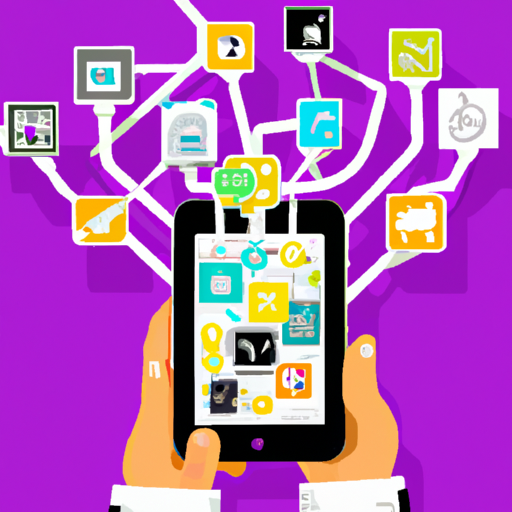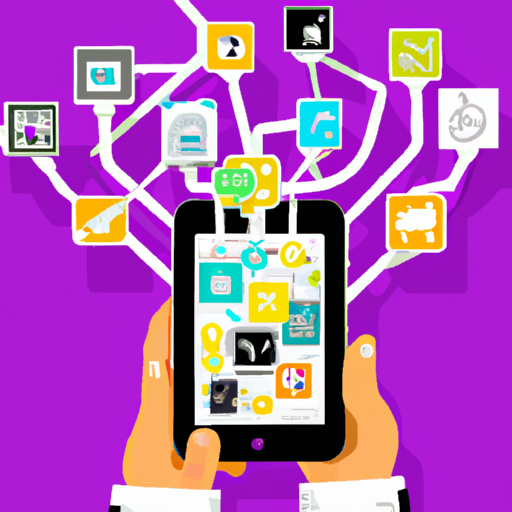Mobile App Industry Trends
So you want to stay up-to-date with the latest trends in the mobile app industry? Well, you’ve come to the right place! In this article, we will explore the ever-evolving world of mobile apps and highlight the key trends that are shaping the industry. From the rise of artificial intelligence and augmented reality to the growing importance of user privacy and personalization, we’ll delve into the exciting developments and shifts that are reshaping the way we interact with mobile applications. Get ready to discover the cutting-edge trends that are revolutionizing the mobile app industry!

Table of Contents
Heading 1: Market Growth
Increasing smartphone adoption worldwide
The mobile app industry has experienced significant growth in recent years, largely due to the increasing adoption of smartphones worldwide. As more individuals gain access to affordable and feature-rich smartphones, the demand for mobile apps has skyrocketed. This trend is particularly prominent in emerging markets, where smartphone penetration is rapidly rising. According to research, the number of smartphone users worldwide is expected to reach 3.8 billion by 2021, showcasing the vast potential for growth in the mobile app market.
Emerging markets driving growth
Emerging markets, such as India, China, and Brazil, have become the driving force behind the growth of the mobile app industry. These regions are witnessing a surge in smartphone adoption, as the availability of affordable devices and access to affordable internet continues to expand. Mobile app developers are targeting these markets to tap into the enormous user base and capitalize on the growing demand for mobile apps. This market trend emphasizes the need for app developers to tailor their offerings to suit the preferences and needs of these specific markets.
Rise of app usage across various industries
The rise of mobile apps is not limited to a single industry or sector. Today, apps are being used across various industries to enhance user experiences and streamline processes. Industries such as healthcare, finance, retail, and education have witnessed a significant surge in mobile app usage. For instance, healthcare apps are revolutionizing the way patients access medical information and interact with healthcare providers. Similarly, finance apps are transforming the way users manage their finances, make payments, and track their investments. The widespread adoption of mobile apps across industries highlights the immense potential for growth in this ever-evolving market.
Heading 2: App Store Optimization (ASO)
Importance of ASO for app visibility
App Store Optimization (ASO) plays a crucial role in ensuring the visibility and discoverability of mobile apps. With millions of apps available on various app stores, it is essential for app developers to optimize their app listings to increase visibility and attract users. ASO involves optimizing app titles, descriptions, keywords, and screenshots to improve app rankings in search results. By implementing effective ASO strategies, app developers can increase organic downloads and improve their app’s chances of success in a highly competitive market.
Use of relevant keywords in app titles and descriptions
One of the fundamental aspects of ASO is the use of relevant keywords in app titles and descriptions. By conducting keyword research and identifying relevant keywords that resonate with the target audience, app developers can improve their app’s visibility in search results. It is important to choose keywords that accurately describe the app’s functionality and features while aligning with users’ search queries. By incorporating these keywords strategically in the app’s title and description, developers can increase the likelihood of their app appearing in relevant search results.
Importance of positive ratings and reviews
Positive ratings and reviews are crucial elements of ASO that significantly impact an app’s visibility and credibility. App stores prioritize apps with higher ratings and positive reviews, as it indicates that the app offers a valuable and satisfactory user experience. App developers should actively encourage users to rate and review their app, preferably after a positive interaction or milestone within the app. Moreover, promptly addressing any negative reviews or feedback is essential to maintain a positive app reputation and increase the chances of app store featuring and promoting the app.
Heading 3: User Experience (UX)
Focus on intuitive and user-friendly interfaces
User experience (UX) plays a pivotal role in determining the success of a mobile app. Users expect apps to have intuitive and user-friendly interfaces that require minimal effort to navigate and operate. App developers should prioritize simplicity, ensuring that users can easily understand and use the app’s features without any confusion. By conducting user testing and gathering feedback, developers can continuously improve the app’s UX, resulting in higher user satisfaction and increased app usage.
Personalization and customization options in apps
In today’s digital era, users increasingly demand personalized experiences to suit their individual preferences and needs. Mobile apps that offer personalization and customization options tend to have higher user engagement and retention rates. App developers can integrate features such as personalized recommendations, customizable settings, and user profiles to enhance the overall user experience. By allowing users to tailor the app according to their preferences, developers can create a sense of ownership and foster long-term user loyalty.
Seamless navigation and reduced loading times
Seamless navigation and reduced loading times are critical factors in delivering a positive user experience. Users expect apps to be quick, responsive, and devoid of any significant delays. Slow loading times and complicated navigation can lead to user frustration and abandonment. App developers should prioritize optimizing their apps for superior performance, ensuring minimal loading times and smooth transitions between screens. By leveraging advanced technologies and optimization techniques, developers can enhance app performance and ensure seamless navigation, resulting in higher user satisfaction.
Heading 4: Augmented Reality (AR) and Virtual Reality (VR)
Integration of AR and VR technologies into mobile apps
Augmented Reality (AR) and Virtual Reality (VR) technologies have revolutionized the way users interact with mobile apps. From immersive gaming experiences to interactive shopping platforms, AR and VR have opened up new possibilities for app developers. By integrating AR and VR technologies into their apps, developers can create unique and immersive experiences that engage users on a deeper level. For example, AR can be used in apps to overlay digital information onto the real world, providing users with enhanced visualizations and interactive elements.
Enhanced gaming experiences with AR and VR
The gaming industry has seen tremendous advancements with the integration of AR and VR technologies into mobile apps. With AR, users can immerse themselves in an augmented virtual world and interact with virtual objects in their real environment. Similarly, VR creates highly immersive environments that transport users to entirely different realms. These technologies have transformed mobile gaming, creating new opportunities for developers to create captivating and engaging gaming experiences.
Potential applications in education, healthcare, and retail sectors
AR and VR technologies have extended their reach beyond gaming and are increasingly being adopted in other sectors such as education, healthcare, and retail. In education, AR and VR can facilitate interactive learning experiences, allowing students to visualize complex concepts and engage in virtual simulations. In healthcare, these technologies can be used for medical training, patient education, and even virtual consultations. The retail industry can benefit from AR and VR by offering virtual try-on experiences, allowing customers to visualize products before making a purchase decision. The potential applications of AR and VR in these sectors are vast and continue to evolve as technology advances.
Heading 5: Internet of Things (IoT)
Integration of mobile apps with IoT devices
The Internet of Things (IoT) has emerged as a significant trend in the mobile app industry. IoT refers to the interconnected network of physical devices that can communicate and exchange data with each other. Mobile apps are increasingly being integrated with IoT devices, allowing users to control and monitor various aspects of their connected environments. For example, users can control their smart home devices, such as thermostats, lights, and security systems, using a mobile app. This seamless integration between mobile apps and IoT devices provides users with enhanced convenience and control over their surroundings.
Smart homes and connected appliances
One of the most prominent applications of IoT in mobile apps is in the realm of smart homes and connected appliances. Mobile apps enable users to remotely control and monitor their smart devices, such as smart thermostats, lights, and home security systems. This level of automation and control enhances the overall user experience, making it easier for individuals to manage their homes efficiently. From adjusting the temperature to turning off lights and even receiving notifications about potential security threats, mobile apps empower users to have complete control over their smart homes.
IoT-powered wearable devices
Wearable devices, such as smartwatches and fitness trackers, have gained immense popularity in recent years. These devices are equipped with sensors that collect various data points, such as heart rate, sleep patterns, and physical activity. To make the most of these wearable devices, mobile apps are developed to sync and analyze the collected data, providing users with valuable insights and personalized recommendations. These apps enable users to track their health and fitness goals, set reminders, and receive real-time data updates, thereby promoting a healthier lifestyle.
Heading 6: Artificial Intelligence (AI) and Machine Learning (ML)
Use of AI chatbots for customer support
Artificial Intelligence (AI) and Machine Learning (ML) technologies have transformed the way mobile apps interact with users. AI-powered chatbots are being employed in mobile apps to provide real-time and personalized customer support. These chatbots can understand and respond to user queries, offer recommendations, and even execute tasks seamlessly. By incorporating AI chatbots, app developers can enhance the overall user experience and reduce the need for manual customer support, leading to cost savings and improved customer satisfaction.
Machine learning algorithms for personalized app recommendations
Machine Learning algorithms are leveraged in mobile apps to provide personalized app recommendations to users. By analyzing user behavior, preferences, and past interactions, these algorithms can offer tailored suggestions that align with the user’s interests. Personalized recommendations enhance the app discovery process, ensuring that users are presented with relevant and engaging content. This not only increases user engagement but also increases the chances of app monetization through increased app usage and in-app purchases.
AI-based app analytics and insights
AI and ML technologies are also applied to app analytics and insights, providing developers with valuable data-driven insights into user behavior and app performance. These technologies can analyze vast amounts of data, such as user interactions, demographics, and app usage patterns, to identify trends and make informed decisions. By leveraging AI-based app analytics, developers can gain a deeper understanding of their target audience, identify areas for improvement, and optimize their app’s performance accordingly. This data-driven approach enables developers to create more successful and user-centric apps.
Heading 7: Mobile Commerce (mCommerce)
Rise of in-app purchases and mobile payments
Mobile Commerce (mCommerce) has experienced exponential growth in recent years, with an increasing number of users making purchases directly from their mobile apps. In-app purchases allow users to make transactions seamlessly within the app, eliminating the need to navigate to external websites. Moreover, mobile payment options, such as mobile wallets and digital payment gateways, have become more secure and convenient, further driving the adoption of mCommerce. With the growing popularity of mCommerce, app developers need to prioritize integrating secure and user-friendly payment options to capitalize on this trend.
Integration of mobile wallets and payment gateways
Mobile wallets and payment gateways play a crucial role in facilitating secure and seamless mobile transactions. They enable users to store their payment information securely and make purchases with just a few taps on their mobile devices. The integration of mobile wallets and payment gateways within mobile apps simplifies the checkout process, reducing friction and increasing conversion rates. App developers should ensure that their apps support popular mobile payment options and comply with the necessary security standards to build trust among users and maximize mCommerce potential.
Improved security measures for mCommerce transactions
As mCommerce continues to rise, ensuring the security of mobile transactions becomes paramount. App developers need to prioritize implementing robust security measures to protect user data, prevent fraudulent activities, and provide a safe shopping environment. This includes encrypting sensitive user information, adhering to industry-standard security protocols, and regularly updating app security features. By instilling trust and confidence in users, app developers can overcome any apprehensions regarding mobile transactions, further fueling the growth of mCommerce.
Heading 8: Cross-Platform Development
App development frameworks for multiple platforms
Cross-platform development frameworks have gained popularity in recent years as they enable developers to build apps that can run seamlessly across multiple operating systems and platforms. These frameworks, such as React Native and Flutter, allow developers to write code once and deploy it on both iOS and Android platforms, saving time and effort. By leveraging cross-platform development frameworks, app developers can reach a broader user base and reduce the complexities associated with developing separate apps for different platforms.
Advantages of cross-platform development
Cross-platform app development offers numerous advantages for app developers. Firstly, it enables faster app deployment, as a single codebase can be used across multiple platforms, eliminating the need for platform-specific development. Secondly, cross-platform apps have a shorter development cycle, as developers can simultaneously work on both iOS and Android versions of the app. This accelerates time-to-market and allows developers to stay ahead of the competition. Lastly, cross-platform apps are easier to maintain and update, as changes made to the codebase apply to all platforms simultaneously.
Challenges and considerations for cross-platform apps
While cross-platform development offers numerous advantages, developers must also consider certain challenges and limitations. Compatibility issues may arise when integrating platform-specific functionalities, requiring additional efforts to ensure seamless functionality across all platforms. Additionally, cross-platform apps may face performance limitations compared to native apps due to the abstraction layers involved. Developers need to strike a balance between cross-platform compatibility and delivering a native-like user experience to ensure optimal app performance and user satisfaction.
Heading 9: App Monetization Strategies
In-app advertising and sponsored content
In-app advertising has become a popular monetization strategy for app developers. By incorporating targeted advertisements within their apps, developers can generate revenue through ad impressions and clicks. Additionally, sponsored content allows developers to partner with brands and promote their products or services within the app. While in-app advertising can be an effective revenue stream, it is essential for developers to strike a balance between ad frequency and user experience, ensuring that ads are relevant and non-intrusive.
Freemium models and in-app purchases
Freemium models offer apps that are free to download but include premium features or content that can be unlocked through in-app purchases. This approach allows developers to attract a large user base while providing opportunities for users to upgrade to premium versions for enhanced functionality. In-app purchases, such as virtual goods, additional levels, or premium subscriptions, provide a steady revenue stream for developers. Successful implementation of freemium models and in-app purchases relies on offering valuable and compelling upgrades that motivate users to make purchases.
Subscription-based app monetization
Subscription-based models have gained popularity, especially among content-based apps such as streaming services, news publications, and productivity tools. By offering tiered subscription plans with exclusive features and benefits, app developers can generate recurring revenue from loyal and engaged users. Subscription-based app monetization relies on consistently delivering high-quality content or services that provide ongoing value to users, encouraging them to maintain their subscriptions. This model can be particularly beneficial for developers seeking a stable and predictable revenue stream.
Heading 10: App Security
Importance of robust security measures
App security is of utmost importance in today’s digital landscape. With the increasing number of mobile apps and the sensitive data they collect, developers must prioritize implementing robust security measures. This includes incorporating data encryption, secure authentication processes, and vulnerability assessments. By prioritizing app security, developers can protect user data from unauthorized access, maintain user trust, and mitigate the risk of data breaches or cyber attacks.
Protecting user data and privacy
Mobile apps often collect and store user data, ranging from personal information to financial details. App developers must ensure that user data is adequately protected and that privacy policies are transparently communicated to users. Implementing secure data storage practices, complying with data protection regulations, and obtaining user consent for data collection are essential steps in safeguarding user data and privacy. By prioritizing user privacy, app developers can build trust with their users and foster long-term relationships.
Mitigating risks of app vulnerabilities
Mobile apps can be vulnerable to various security threats, such as malware, phishing attacks, and unauthorized access. App developers must conduct regular vulnerability assessments and adopt best practices in secure coding to identify and mitigate potential risks. Applying security patches and updates promptly, regularly testing app security, and educating app users about security best practices are crucial steps in minimizing app vulnerabilities. By taking a proactive approach to app security, developers can reduce the likelihood of security breaches and protect both their app and users from potential harm.






